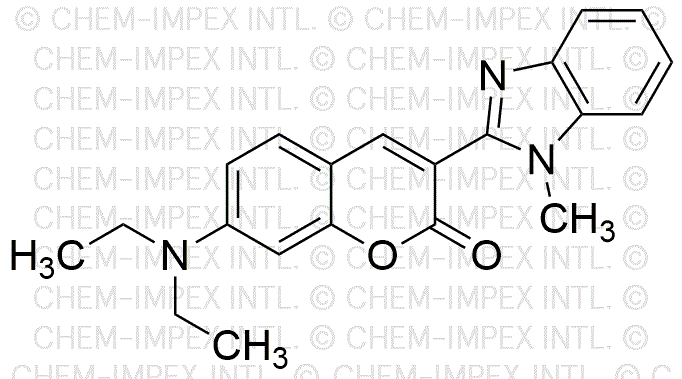7-(Diethylamino)-3-(1-methyl-2-benzimidazolyl)coumarin is widely utilized in research focused on:
- Fluorescent Probes: This compound is used as a fluorescent marker in biological imaging, allowing researchers to visualize cellular processes in real-time.
- Photodynamic Therapy: It has applications in cancer treatment, where it can be activated by light to produce reactive oxygen species that selectively destroy cancer cells.
- Biochemical Assays: The compound serves as a reagent in various biochemical assays, helping to detect and quantify biomolecules with high sensitivity.
- Drug Development: It plays a role in the development of new pharmaceuticals, particularly in designing compounds that target specific biological pathways.
- Environmental Monitoring: This chemical is also used in environmental science to detect pollutants, providing valuable data for ecological studies.
General Information
Properties
Safety and Regulations
Applications
7-(Diethylamino)-3-(1-methyl-2-benzimidazolyl)coumarin is widely utilized in research focused on:
- Fluorescent Probes: This compound is used as a fluorescent marker in biological imaging, allowing researchers to visualize cellular processes in real-time.
- Photodynamic Therapy: It has applications in cancer treatment, where it can be activated by light to produce reactive oxygen species that selectively destroy cancer cells.
- Biochemical Assays: The compound serves as a reagent in various biochemical assays, helping to detect and quantify biomolecules with high sensitivity.
- Drug Development: It plays a role in the development of new pharmaceuticals, particularly in designing compounds that target specific biological pathways.
- Environmental Monitoring: This chemical is also used in environmental science to detect pollutants, providing valuable data for ecological studies.
Documents
Safety Data Sheets (SDS)
The SDS provides comprehensive safety information on handling, storage, and disposal of the product.
Product Specification (PS)
The PS provides a comprehensive breakdown of the product’s properties, including chemical composition, physical state, purity, and storage requirements. It also details acceptable quality ranges and the product's intended applications.
Certificates of Analysis (COA)
Search for Certificates of Analysis (COA) by entering the products Lot Number. Lot and Batch Numbers can be found on a product’s label following the words ‘Lot’ or ‘Batch’.
Número de catálogo
Número de lote/lote
Certificates Of Origin (COO)
This COO confirms the country where the product was manufactured, and also details the materials and components used in it and whether it is derived from natural, synthetic, or other specific sources. This certificate may be required for customs, trade, and regulatory compliance.
Número de catálogo
Número de lote/lote
Safety Data Sheets (SDS)
The SDS provides comprehensive safety information on handling, storage, and disposal of the product.
DownloadProduct Specification (PS)
The PS provides a comprehensive breakdown of the product’s properties, including chemical composition, physical state, purity, and storage requirements. It also details acceptable quality ranges and the product's intended applications.
DownloadCertificates of Analysis (COA)
Search for Certificates of Analysis (COA) by entering the products Lot Number. Lot and Batch Numbers can be found on a product’s label following the words ‘Lot’ or ‘Batch’.
Número de catálogo
Número de lote/lote
Certificates Of Origin (COO)
This COO confirms the country where the product was manufactured, and also details the materials and components used in it and whether it is derived from natural, synthetic, or other specific sources. This certificate may be required for customs, trade, and regulatory compliance.


